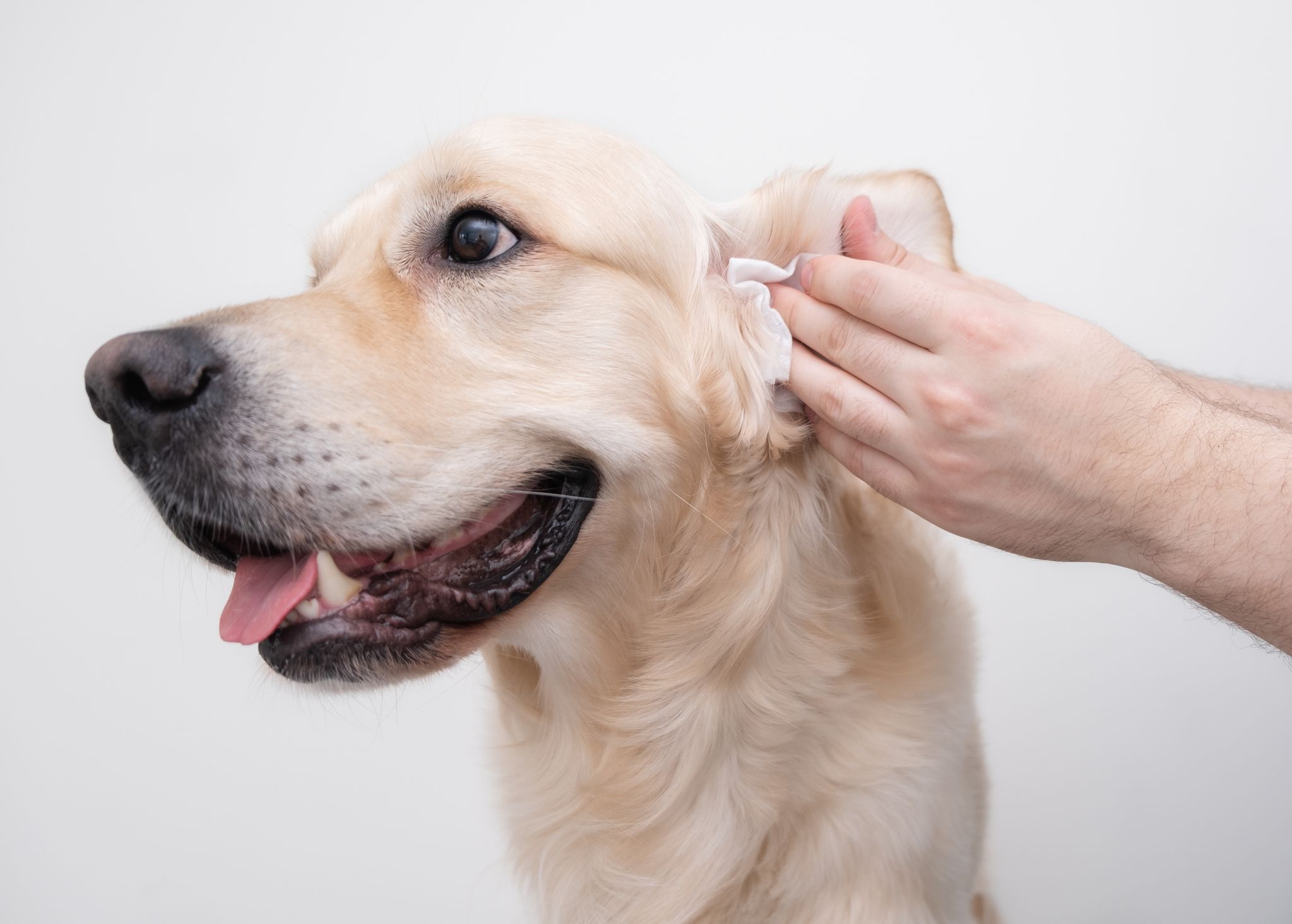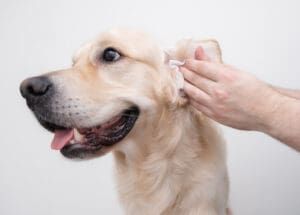Some dogs’ ears stay clean without any attention or effort from us, but other dogs’ ears are prone to developing a dirty, stinky state unless they are cleaned regularly. The accumulation of ear wax, dirt, and debris invites the development of fungal and bacterial infections and ear mite infestations. Using homemade ear cleaner for dogs can keep your dog’s ears clean and free of funky buildup. It will go a long way towards preventing these problems.
Ingredients for dog ear-cleaning solutions
There are dozens of recipes for homemade ear washes for dogs, and opinions differ as to which are the best and why. To experiment with your own recipes, assemble a clean empty jar or bottle, an eyedropper and measuring cup or spoons, cotton balls or gauze, cotton-tipped applicators, and ingredients like the following:
- Boric acid. A topical treatment for yeast infections in humans and canines, this dry powder is widely used as an ingredient in ear cleaners. It has antiseptic properties and aids in drying and acidifying the ear canal, which discourages yeast and bacterial growth. Small amounts of boric acid (sold in pharmacies) can be combined with liquid ingredients to create an ear rinse or wash.
- Vinegar, whether white distilled or apple cider vinegar, helps dissolve earwax and debris while protecting against yeast and bacteria. It should always be diluted with water or other appropriate liquids to prevent irritation and damage to the ear canal’s delicate skin.
- Alcohol (isopropyl or rubbing alcohol as well as ethanol) is an effective and fast-acting disinfectant, destroying bacteria, viruses, yeasts, and fungi. Its drying properties help maintain a healthy ear environment. However, it can be painful when applied full-strength. Always dilute alcohol with less irritating liquids (such as water, green tea, or aloe vera juice) to avoid painful burning.
- Witch hazel, an herbal extract used for its skin-friendly astringent properties, can be used in ear rinses, but commercial brands like Thayer’s and Dickenson’s contain alcohol, which can irritate inflamed skin. Always dilute with other liquids.
- Green tea, brewed from the leaves and buds of Camellia sinensis, is known for its antioxidant and anti-inflammatory properties. Several holistic veterinarians, including Dr. Pitcairn, recommend brewing it full-strength for use in a dog’s ear rinse. Pour a cup of boiling water over a teabag or teaspoon of green tea herb, let it stand until cooled to room temperature, then strain and apply.
- Aloe vera juice or gel helps maintain ear health by drying, soothing, and cleaning the ear canal. It can be applied alone or combined with other ingredients to create a soothing, healing wash or rinse.
- Glycerin is a colorless, odorless, viscous, non-toxic liquid that is included in canine ear cleaners as a thickening agent and to distribute other ingredients evenly throughout the ear canal. It is unlikely to cause irritation or allergic reactions, and it helps keep the skin supple and comfortable.
- Don’t use: Hydrogen peroxide is a liquid disinfectant, bleaching agent, and antiseptic. Diluted to 3% by weight, it’s sold for consumer use, and its higher concentrations have industrial applications. Hydrogen peroxide is not recommended for cleaning a dog’s ears because unless greatly diluted, it can cause burning, stinging, or discomfort.
Combine ingredients of your choice for an effective and comfortable ear rinse for your dog. Or try one of these sample recipes:
Before you clean those ears
Before you start using any ear-cleaning solution, make sure your dog doesn’t have an ear infection or mite infestation already. If your dog has been scratching his ears, or tilting or shaking his head or rubbing it on the floor, he should be seen by your veterinarian – particularly if his ear canals are red or inflamed and/or they have an unpleasant odor. These symptoms accompany ear infections, so if they’re present and persistent, see your veterinarian. Ear infections should not be ignored as they are painful and can lead to hearing loss.
If you’re sure your dog’s ears are not currently infected – they just tend to get gunky, smell yeasty, or stay wet because of frequent swims – cleaning his ears at home can help prevent recurrent infections.
Rinse 1
Mix 4 tablespoons (2 fluid ounces or 1/4 cup) white or apple cider vinegar with the same amount of water, green tea, or aloe vera juice. Then add 1/2 teaspoon boric acid, 5 drops of isopropyl rubbing alcohol, and 2 drops glycerin. Shake well to mix ingredients.
Rinse 2
Add 1/4 water to 1/4 cup vinegar, add 2 tablespoons witch hazel, 2 tablespoons boric acid, and 1 tablespoon aloe vera gel. Shake well.
Rinse 3
Brew 1/2 cup of freshly brewed green tea and cool to room temperature. Use this rinse by itself or add 2 tablespoons boric acid and shake well.
How to use homemade dog ear cleaner
Cleaning the ears and keeping them dry is an important preventive measure because persistent moisture in a dog’s ears encourages harmful bacteria to thrive. All you need is a dog-safe ear-cleansing solution and cotton balls, gauze, and/or cotton-tipped applicators.
- Make sure your cleaning solution is warmed to a comfortable temperature. You can immerse your jar of cleaning solution in a bowl of hot water until the ear cleaner has reached something close to your body temperature. Drip a few drops of the solution onto your bare wrist; if it’s neither hot nor cold, it’s just right.
- Apply enough cleansing solution to a cotton ball to make it wet. Place the soaked cotton in your dog’s ear and press it to release the solution. Most dogs prefer this to having cleanser squirted into the ear. If your dog is still cooperative, massage the ear canal from the outside at the base of the ear opening, helping distribute the solution throughout the ear. Be prepared: When you let go of the dog’s ear, your dog may vigorously shake her head, splattering cleaning solution all around your immediate environment!
- Gently wipe the ear with cotton or gauze, replacing it with a fresh piece after each wipe until the ear is clean and dry. Stop cleaning if the ear begins to bleed or if the ear cleaning causes pain.
- Gently remove debris from the ear’s nooks and crannies with a cotton-tipped applicator. Q-Tips and other cotton-tipped applicators should be used only in areas where you can see; reaching too deep into the ear could accidentally rupture your dog’s eardrum.
- Repeat with the other ear. Many veterinarians recommend cleaning the ears twice a week to treat or prevent infection, then every week or every other week for routine maintenance.
For more information, see “Prevent Dog Ear Infections by Cleaning Your Dog’s Ears.”

